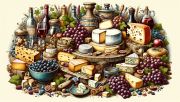
Mastering the Art of Slow Cooking and Sous-Vide: A Guide to Perfect Meals Every Time
Unlock the secrets of culinary excellence with slow cooking and sous-vide. Master techniques, equipment, tips, and safety for perfect meals.
Slow cooking and sous-vide are two techniques that can elevate your culinary skills and help you achieve perfect meals every time. Slow cooking involves cooking food at a low temperature for an extended period, allowing the flavors to develop and the meat to become tender. On the other hand, sous-vide is a method of cooking food in a vacuum-sealed bag in a water bath at a precise, consistent temperature. Both methods have their benefits and can be used to create delicious dishes. In this blog/tutorial, we will explore the basics of slow cooking, including suitable recipes, as well as how sous-vide works and what equipment you need to get started. We will also provide essential tips for mastering both techniques and share the secret to achieving perfect results every time. Additionally, we will compare slow cooking with sous-vide and discuss when to use each method. Furthermore, we will cover safety tips for both techniques and provide guidance on cleaning and maintaining your slow cooker and sous-vide equipment. By the end of this guide, you will have the knowledge and skills to elevate your culinary repertoire and create restaurant-quality meals at home.
The benefits of cooking your food slowly or using sous-vide are numerous. Slow cooking allows flavors to develop over time, resulting in rich and tender dishes. It also tenderizes tougher cuts of meat, making them more enjoyable to eat. Additionally, slow cooking allows you to prepare meals in advance and come home to a delicious, ready-to-eat dinner. On the other hand, sous-vide cooking involves vacuum-sealing food and cooking it in a water bath at a precisely controlled temperature. This method ensures that food is cooked evenly and retains its moisture and flavor. Sous-vide also allows for precise control over the cooking process, leading to consistently perfect results every time. Both slow cooking and sous-vide offer convenience, delicious outcomes, and the ability to elevate your culinary skills to the next level.
Slow cooking is a method of cooking that involves cooking food at a low temperature for an extended period. This technique is great for tenderizing tough cuts of meat, infusing flavors, and producing delicious, hearty meals. Some suitable recipes for slow cooking include beef stew, pulled pork, and chicken cacciatore. One important aspect of slow cooking is the use of a slow cooker or crockpot, which allows you to set the temperature and walk away, letting the cooker do all the work. Another crucial element is the use of liquid in the cooking process, such as broth, wine, or water, which helps to keep the food moist and contributes to the overall flavor. With slow cooking, you are guaranteed to come home to a house filled with the irresistible scent of a home-cooked meal. The convenience and delicious results make slow cooking a popular choice for busy individuals and families.
Exploring sous-vide cooking involves understanding the unique method of cooking food in vacuum-sealed bags, submerged in a water bath at a precise temperature. Unlike traditional methods, sous-vide cooking ensures that the food is cooked evenly from edge to edge, resulting in perfectly tender and flavorful dishes. To get started with sous-vide cooking, you will need a sous-vide machine or immersion circulator, vacuum sealer or zipper-lock bags, and a large pot or container for the water bath. Using a sous-vide machine, you can set the precise temperature and cooking time for your desired recipe, allowing for consistent results every time. Whether you're cooking steak, chicken, fish, or vegetables, sous-vide cooking can elevate your culinary skills and impress your family and friends with delicious, restaurant-quality meals.
Mastering slow cooking requires attention to detail and patience, but the results are well worth the time investment. One essential tip for successful slow cooking is to choose the right cut of meat. Tough cuts like chuck or brisket are ideal for slow cooking as they become tender and flavorful when cooked low and slow. Additionally, it's important to sear the meat before adding it to the slow cooker to enhance the flavor and texture of the finished dish. Another crucial tip is to layer ingredients properly, with heartier vegetables at the bottom and more delicate ones towards the top to ensure even cooking. Furthermore, using the right amount of liquid is essential for slow cooking, as too much can water down the flavors while too little can result in dry, overcooked food. Finally, resist the temptation to lift the lid and peek at your creation too often as this can disrupt the cooking process and increase the overall cooking time.
The secret to perfect sous-vide results every time lies in precision and patience. Unlike traditional cooking methods, sous-vide requires careful temperature control to ensure that your food is cooked to perfection. One of the key factors to achieving the best results is investing in a reliable sous-vide machine. This device will maintain a steady water temperature, allowing your food to cook evenly and retain its natural flavors and nutrients. Additionally, using high-quality vacuum-sealed bags is essential for the sous-vide process. These bags prevent the food from coming into contact with the water, preserving its texture and taste. Another tip for perfect sous-vide results is to season your food before sealing it in the bags, as this will enhance the flavors during the cooking process. Lastly, be patient and allow your food to cook for the recommended time, as rushing the process can lead to uneven results. By following these tips, you can achieve restaurant-quality sous-vide dishes in the comfort of your own kitchen.
When it comes to deciding between slow cooking and sous-vide, it all boils down to the time and texture you desire in your meals. Slow cooking is perfect for dishes that benefit from long, low-temperature cooking, such as stews, roasts, and braised meats. The consistent heat and lengthy cooking time tenderize tough cuts of meat and infuse the flavors of the ingredients. On the other hand, sous-vide is ideal for precision cooking, especially for delicate proteins like fish and eggs. The vacuum-sealed bags ensure that the food is cooked evenly at a specific temperature, resulting in perfectly cooked tender and moist dishes. While slow cooking is great for set-it-and-forget-it convenience, sous-vide requires more precision and attention but guarantees consistent and impressive results every time.
When it comes to slow cooking and sous-vide, safety is of utmost importance to ensure that you and your loved ones can enjoy delicious meals without any risks. Firstly, always follow the manufacturer's instructions for your slow cooker and sous-vide equipment. This includes proper usage, maintenance, and safety precautions. It's essential to never leave your slow cooker or sous-vide machine unattended, as this can lead to potential hazards. Additionally, always use a food thermometer to ensure that your food reaches the proper internal temperature, especially when cooking meats. When working with sous-vide, be cautious with the hot water bath and be sure to use protective gear such as oven mitts to prevent burns. Always follow recommended cooking times and temperatures to ensure that your food is cooked thoroughly and safely. And lastly, when working with vacuum-sealed bags for sous-vide, be sure to use BPA-free bags that are specifically designed for sous-vide cooking to avoid any health risks.
Cleaning and maintaining your slow cooker and sous-vide equipment is essential to ensure the longevity and performance of these cooking tools. For your slow cooker, always start by unplugging the appliance and allowing it to cool down before cleaning. The stoneware insert and lid are usually dishwasher safe, but check the manufacturer's instructions to be sure. For tougher, stuck-on food residue, soak the insert in warm, soapy water before scrubbing with a non-abrasive sponge. Wipe down the exterior of the slow cooker with a damp cloth. As for sous-vide equipment, it's crucial to thoroughly dry the immersion circulator and water bath after each use to prevent the growth of bacteria. Be sure to clean the water bath and container thoroughly as well, using a mild soap and water solution. Periodically check the seals of the sous-vide bags and the vacuum sealer to ensure they are in good condition. By following these cleaning and maintenance tips, you can continue to enjoy delicious meals prepared with your slow cooker and sous-vide equipment for years to come.
In conclusion, slow cooking and sous-vide techniques are both excellent ways to elevate your culinary skills and impress your family and friends with consistently perfect results. Slow cooking allows for the convenience of preparing delicious, tender, and flavorful dishes with minimal effort, while sous-vide cooking provides a unique method of achieving precise and consistent results every time. By mastering these techniques, you can create restaurant-quality meals in the comfort of your own kitchen, making every dining experience a memorable one. Whether you're a busy individual looking for convenient meal preparation or a passionate home chef eager to explore new cooking methods, incorporating slow cooking and sous-vide into your culinary repertoire will undoubtedly take your skills to the next level.
Related posts





